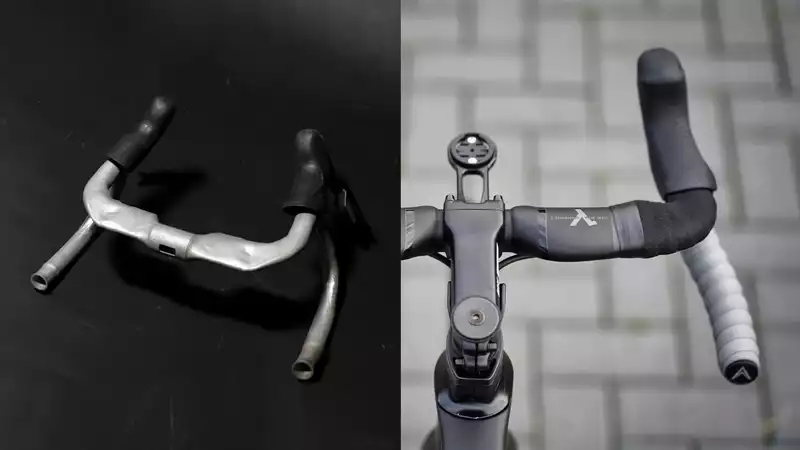Every season, the UCI rules are announced that have riders scratching their heads. In the past, it was sock height, which of course had a related trick. And this season, it's the tightening of shifter hoods against extreme inversion, adopted by many riders in 2023.
Victor Kampaerts thinks the rule is "bullshit," but Adam Hansen of the CPA Riders Union has explained well that it is based on legitimate safety concerns. In any case, a lever that deviates more than 10 degrees inward from the plane of the drop is ...... Well, they will probably just be "told to shift it a bit," but they will definitely be subject to a fine.
As well as new rules come products to get around them. In a curious search at the end of the day, I stumbled across two new pairs of handlebars that have been specifically designed and marketed to comply with the UCI's new lever rules. Both are quite radical, with large flares and extremely narrow tops to allow the rider to create the smallest possible frontal area.
The numbers on these bars alone are quite staggering. The outermost drops are 350mm apart, hitting the UCI minimum width for a drop bar at the nose, but then flare sharply inward to create a hood position that is only 21cm apart at its widest point and 147mm apart at its narrowest point.
The top is aerofoil shaped, albeit slightly given the width of the bar, but from the images in use it appears that this deep profile is used more as a forearm rest than as a wind deceiver per se.
Even more surprising than the price is the reach of the bar. There is 24 cm from the rear of the clamping area to the tip of the hood.
The bars are UCI compliant and are already registered for use at the Paris Olympics.
The bar corresponds not only to the letter of the law, but also to its spirit, claiming to be designed for strength in the inward turned position. It is 3D printed from steel, which is certainly a novel material approach and not one we encounter regularly. Despite this, it weighs a respectable 380 grams and claims to be 3% more aerodynamically efficient than a 40 cm bar at 386 W and 45 km/h.
And while the price tags of €1,390 for an off-the-shelf pair and €1,990 for a custom set are commensurate with the 3D-printed components, they are not likely to be a pair you'd immediately see on your local club run.
Fortunately, for those of us with shallow pockets, there are German-made carbon alternatives that are light enough to make the price worth it. Lambda Tuning's Crosswing Bar (apparently not "X-Wing," but since that name is copyrighted ...... thanks to George Lucas) has similar features to the Asha RR, but the shape is less extreme. It must be said that this probably makes it more user-friendly for the average riding enthusiast.
At the narrowest drop of 40 cm, the hood width is 32 cm, and at the maximum allowable inner flare, the hood tips are 24 cm apart. Like the Asha RR, the bars are designed to accommodate this inward inflection for gravel riding.
The reach is a very normal 72mm, and to facilitate retrofitting of parts, the bar has internal routing, which is unusual for a bar, but only in the final stage before the clamp area. A large groove in front of it allows it to be installed on the bike without removing the brakes and bleeding (if using disc brakes).
The Cross-Wing also features a relatively low drop of 105 mm. Presumably indicating that riders will likely stay with the drop for general riding and switch to a narrower hood for coordinated efforts.
Other key figures are: weight 210 g, 23 watts more at 40 km/h (presumably from a standard 40 cm round bar, but this has not been confirmed), 20 degrees flare (drop is parallel), 25 mm forward sweep For those who find the 32 cm hood width a bit narrow, 42 cm and 43 cm ( drop section) versions are also available, priced at €219 for the full width.
.

Comments